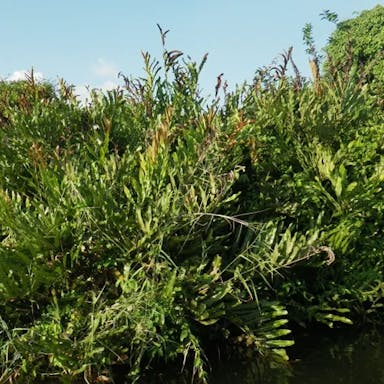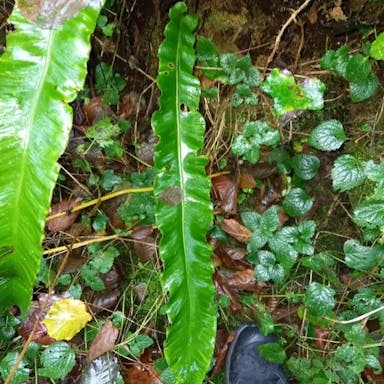The flower language commonly used in America for the plant Flowering fern is: - Sincerity - Magic - Fascination One typical example is "Sincerity," symbolizing honesty and genuine feelings. This reflects the Flowering fern's delicate beauty and the sincerity it represents in various relationships.
Flowering fern
- Scientific name
- Helminthostachys zeylanica
Basic Information
- Ophioglossaceae Family Helminthostachys Genus Flowering fern Species
- Ophioglossaceae > Helminthostachys > Helminthostachys zeylanica
- 83%
- The Completeness of This Encyclopedia
Please help us complete the encyclopedia, Terrarium is a encyclopedia service to be completed with everyone in the world. Currently, this page is 83% complete. For more information on how to contribute, please click here.
- Pteridophyta
- Height
- 100cm ~
- Flower Color
- Leaf Color
- Anthesis
- Sunlight Exposure
Full Sun Long hours of sunlight from morning to afternoon Partial Shade A location in the shade of a tree or where either the morning or afternoon is shaded Full Shade A place where there is no direct sunlight
- Partial Shade
- Hardiness Zones
This is an indicator to know to which zone each plant can winter. Knowing the zone of each plant gives you an idea of the cold temperature resistance when grown in the ground without a roof. 2: -42.7 to -40.0 3: -39.9 to -34.4 4: -34.3 to -28.9 5: -28.8 to -23.3 6: -23.2 to -17.8 7: -17.7 to -12.2 8: -12.1 to -6.7 9: -6.6 to -1.1 10: -1.0 to 4.4 11: 4.5 to 10.0
- 10
- Cold resistance
- Fair
- Heat resistance
- Good
- Habitat of origin
- India, Sri Lanka
- Growth Rate
- Normal
What is Flowering fern (Helminthostachys zeylanica)?
What is Flowering fern (Helminthostachys zeylanica)
Flower meaning
For the Flowering fern, watering frequency should be moderate, typically once every 7-10 days during the growing season. Ensure the soil remains consistently moist but not waterlogged to prevent root rot. During the dormant season, reduce watering to once every 2-3 weeks to mimic the plant's natural growth cycle. Check soil humidity by inserting a finger 1-2 inches deep into the soil; if it feels dry, it's time to water. Water the plant thoroughly, allowing excess water to drain out of the pot to avoid water accumulation at the roots.
Calendar of Flowering fern (Helminthostachys zeylanica)
Calendar
Flowering fern offers two main varieties: 1) Variety A has delicate fronds with a lighter green hue and thrives in shaded areas with high humidity. It is ideal for indoor cultivation. 2) Variety B features broader fronds with a darker green color, preferring partial shade and moderate watering. When selecting seeds, opt for plump, firm ones without signs of mold or damage. For seedlings, choose those with vibrant green leaves and a well-established root system. Ensure the soil is well-draining and rich in organic matter for successful growth.
How to grow Flowering fern (Helminthostachys zeylanica)
Watering
The Flowering fern thrives in partial to full shade, making it ideal for areas with limited direct sunlight. It exhibits moderate cold tolerance, able to withstand temperatures as low as 50°F (10°C). It prefers temperatures between 60-75°F (15-24°C) and should be protected from extreme heat. During summer, it benefits from being placed in a location with indirect sunlight to prevent leaf scorch. In winter, it can be overwintered indoors in a cool, bright room. Flowering ferns are sensitive to too much direct sunlight, so it is best to provide them with filtered light or morning sun. They require around 4-6 hours of sunlight per day to thrive and should be shielded from harsh afternoon sun.
Soil and Fertilizer
Flowering fern benefits from regular pruning to maintain its shape and promote healthy growth. Pruning is necessary to remove dead or damaged fronds, improve air circulation, and encourage new growth. The best time to prune is in early spring before new growth emerges. When pruning, use clean, sharp tools to make precise cuts at the base of the frond or stem. Remove any yellowing or brown fronds to enhance the plant's appearance. After pruning, water the plant thoroughly to help it recover and apply a balanced fertilizer to support new growth. Regular pruning will help Flowering fern thrive and remain vibrant.
Sunlight and Place
Flowering fern thrives in well-draining soil with high organic matter content. It prefers slightly acidic to neutral soil pH levels between 5.5 and 7.0. Regularly applying a balanced fertilizer with an N-P-K ratio of 10-10-10 or similar during the growing season can promote healthy growth. Fertilizer should be applied every 4-6 weeks from spring to early fall, following the manufacturer's instructions for the correct amount. Avoid over-fertilizing, as it can lead to nutrient imbalances and harm the plant. Conduct a soil test annually to monitor nutrient levels and adjust the fertilizer application accordingly.
Advanced Information of Flowering fern (Helminthostachys zeylanica)
Pruning
Flowering fern is best potted in a well-draining mix of peat moss and perlite. Ensure the pot has drainage holes to prevent waterlogging, which can lead to root rot. When planting, gently loosen the roots and place the fern in the center of the pot at the same depth as it was in the nursery container. Water thoroughly after planting and keep the soil consistently moist but not waterlogged. Repotting should be done every 1-2 years in the spring, moving the fern to a slightly larger pot. Misting the fronds regularly can help maintain humidity levels.
Planting and Harvest
Flowering fern propagates best through spores, which are produced on the underside of fronds. To sow spores, collect mature fronds, place them in a paper bag to dry, then shake to release spores onto a moist growing medium. Keep the medium moist and covered to maintain humidity. For division, carefully separate the rhizomes with roots and plant them in individual pots. Cuttings can be taken from healthy fronds, removing them at the base and planting them in a well-draining medium. Leaf cuttings involve cutting a healthy leaf into sections and planting them in a similar medium. To ensure successful propagation, maintain consistent moisture levels and provide indirect light. Harvest spores when they turn brown for sowing.
Propagation
Flowering fern is susceptible to pests such as aphids, mealybugs, and spider mites, which can cause damage by feeding on the plant's foliage and sucking out its sap. These pests can weaken the plant, leading to stunted growth and yellowing of leaves. Preventing infestations can be achieved by regularly inspecting the plant for any signs of pests, maintaining good air circulation around the plant, and using insecticidal soap or neem oil as organic control methods. Additionally, keeping the plant healthy through proper watering and fertilization can help it resist pest attacks. In terms of diseases, Flowering fern is prone to fungal infections like leaf spot and root rot, which can cause wilting, yellowing, and eventual death of the plant. These diseases often thrive in moist conditions, so avoiding overwatering and ensuring proper drainage are crucial in preventing their occurrence.
Pests and Diseases
Flowering fern in the United States typically blooms in late spring to early summer. The flowers are at their best during the month of June. Blooming occurs once a year, lasting for about 2-3 weeks. To extend the blooming period, ensure the plant receives adequate sunlight, water, and nutrients. Maintaining consistent moisture levels in the soil and providing occasional fertilization can also help prolong the flowering time. Avoid overwatering or allowing the soil to dry out completely. Pruning dead fronds and removing any obstacles that may block sunlight can promote continuous blooming.
Habitat of Flowering fern (Helminthostachys zeylanica)
Habitat
Toxicity of Flowering fern (Helminthostachys zeylanica)
Health Benefits
- edible
- edible
- Toxic
- No toxicity
NO DATA
Toxic for dogs and cats
NO DATA











